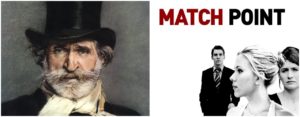
Opera Meets Film: ‘Match Point’ is Woody Allen’s Off-putting Love Letter to Opera
By David Salazar“Opera Meets Film” is a feature dedicated to exploring the way that opera has been employed in cinema. We will select a section or a film in its entirety, highlighting the impact that utilizing the operatic form or sections from an opera can alter our perception of a film that we are viewing. This week’s installment features Jonathan Woody Allen’s “Match Point.”
“Match Point” seems like Woody Allen’s love letter to opera. From its opening credits to its very last, Enrico Caruso’s legendary voice rings through. At once nostalgic and romantic, we are given an anticipation of something that looks back.
But what we get is something completely different. Scene after scene we get an opera recording by Caruso, all the tracks from decidedly different operas. One moment we are in “Il Trovatore,” then “L’Elisir d’Amore,” then in “Les Pêcheurs de Perles.” And then some other works.
It is undeniably connected with protagonist Chris Wilton who proclaims early on that he loves opera. We see him and his new family spend some quality time at the theater watching the likes of “La Traviata” and “Rigoletto.”
Dissonance
What Allen does is create a rather ambiguous relationship with opera and our protagonist. The non-diegetic interventions emphasize the stuffy upper-class society he is stepping into, but the choice to go with old Caruso recordings is somehow dissonant with the clean and cold London that Allen paints. Moreover, many of the pieces and their emotional tone don’t often fit the visual content. One prevalent example is the scene where Chris wanders about his future inlaws awe-inspiring estate as we hear the start of the Manrico-Azucena duet from “Il Trovatore.”
The diegetic uses are just as off-putting as Allen has his characters in a theater but has the performers accompanied by a piano. Even the least knowledgeable opera connoisseur would wonder about where the orchestra was in a massive and elegant theater that the British upper class frequent.
Again, this odd nature and ambiguity match our own relationship with the lead character, an opportunist whose seeming naivete makes him endearing nonetheless. Despite his cold and somehow hollow exterior, he still manages to express some of that warmth we identify with Caruso’s classic sound.
As the drama progresses and Chris finds himself in an uncomfortable affair with Nola Rice, the interjections of opera become less frequent. But Allen is preparing us for his knockout punch.
Music Matches the Act
As he orchestrates his big murder, Allen brings opera right back to the forefront. But he doesn’t use a Caruso recording. In fact, he uses a modern recording with clean audio, the crackling of the old LPs completely gone. The romantic qualities of the character have been done away.
Allen’s selection is also quite telling as he chooses almost the entire ending of Act two from Verdi’s “Otello.” Kicking things off with “Desdemona rea,” the director picks perhaps the most tumultuous section in Verdi’s masterwork, the music growing more and more violent as the titular character lets his insecurities sway his emotional stay.
If Allen had not set up the rest of the film with operatic interjections, the sudden appearance of “Otello” would have been even stranger and somehow forced.
But by setting up the motif from the start, the sudden use of music that fits in with the narrative drive only amplifies the two. As we hear Otello grow more violent, we feel the tension of the scene grow as Chris moves toward murdering Nola.
In a very subtle manner that only Allen could pull off, the auteur throws in a cheeky jab at the opera-musical theater debate by using the latter as the alibi for Chris as he is set to meet his wife Chloe at the theater to see a new show.
Opera commits the crime. Musical theater provides the coverup.


